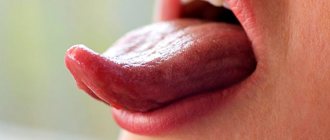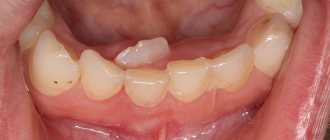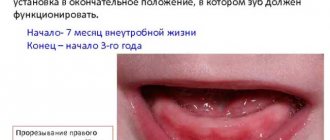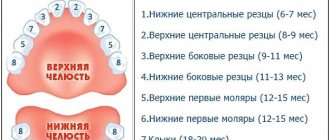How teeth are formed
The appearance of the first tooth is a milestone in a child's development. Now he's almost an adult! After all, his teeth will help him chew solid food and develop speech.
Baby teeth begin to form in the fetus as early as the 6th week of pregnancy. Between the 3rd and 6th months, enamel has already formed on the teeth. All this will be hidden under the gums for the time being. At the same time, deep in the jaw bone there are already the rudiments of molar teeth.
For most children, their first tooth appears between 4 and 7 months, but for some it happens later. With early development, it can erupt at 3 months or earlier. If the child grows normally and has no problems with skin and hair, then it’s okay. But if your baby is already 1.5 years old, and teeth have not appeared, you may need the help of a dentist.
The lower teeth usually appear about a month earlier than the upper teeth.
Approximate order of appearance of baby teeth:
- Lower central incisors (at 6 – 7 months).
- Upper central incisors (at 8 – 9 months).
- Upper lateral incisors (at 9–11 months).
- Lower lateral incisors (at 11 – 13 months).
- Upper small molars (molars) (at 12 – 15 months).
- Lower small molars (molars) (at 12 – 15 months).
- Upper canines (at 16 – 18 months).
- Lower canines (at 18 – 20 months).
- Lower large molars (molars) (at 24 – 30 months).
- Upper large (root) (at 23 – 30 months).
By age 3, your baby should have all 20 teeth, which will last until he is about 6 years old, when his first baby tooth falls out.
Don't be discouraged if your teeth grow crooked at first. Over time they will all fall into place.
Sequence of appearance of teeth
Most children begin teething between 6 and 12 months. They appear in babies in pairs. The lower front teeth come in first, and the upper front teeth usually take a couple of months to emerge. Then the lower and upper lateral incisors emerge, followed by the first molars (the teeth behind the canines), the canines, and the second molars. So, by the age of three, the child will have a set of 20 primary teeth.
| Age | Types of teeth |
| Four - seven months | Central lower incisors |
| Eight - twelve months | Central upper incisors |
| Nine - sixteen months | Lateral lower and upper incisors (next to the middle teeth) |
| One year | The baby has a set of eight teeth |
| Thirteen to nineteen months | First molars (two above and below) |
| Sixteen to twenty-three months | Fangs (two on top and bottom) |
| Twenty-three to thirty-one months | Second molars (lower teeth appear first, then upper teeth) |
This is a general dental growth chart, but not all babies will follow it. Some will be ahead of him, while others will be behind him.
How to understand that your baby is teething (symptoms)
Many people believe that the process of teething must necessarily be accompanied by general anxiety of the baby, fever and diarrhea. However, not all experts share this point of view. Some consider this a mere coincidence. There is an opinion that children, when they start teething, are more likely to put dirty objects in their mouths to scratch their gums, and cause an infection.
Some lucky people go through this period painlessly.
But most children still experience some discomfort:
- Anxiety;
- Increased salivation, which can lead to facial irritation;
- The gums swell and become more sensitive;
- Refusal to eat;
- Bad dream.
If your baby has a fever or diarrhea, consult a doctor.
Symptoms of baby teeth erupting
Each baby reacts individually to the eruption of baby teeth, however, there are characteristic symptoms by which parents can understand that this is happening:
- heavy salivation;
- redness and swelling of the gums;
- itching
Severe itching and sometimes even painful sensations make the child capricious. He becomes restless, which disrupts his sleep. To somehow relieve the itching, children put toys in their mouths and intensively rub their gums. Children often refuse to eat or eat with less appetite. What does the gum look like when teeth come in? Changes in the condition of the gums are one of the criteria by which parents can differentiate teething. The gums in this place look inflamed - they turn red, swell, and immediately at the site of tooth eruption they become white.
However, the biggest concerns about the child’s condition are cough, runny nose, and fever during teething. Indeed, the appearance of baby teeth in its symptoms can resemble colds, and it is difficult for parents without experience to understand whether the baby is sick or is just teething.
First of all, you need to understand that both fever and cough during teething in children are acceptable reactions. Cough, hoarseness, and runny nose are most often the result of excessive salivation. For the same reason, during teething, babies develop a rash on the chin and around the mouth.
Another frequently asked question from parents is what kind of stool can a child have when teething? During a particularly acute period of teething, babies may have weak stools, which is associated with general irritation of the nervous system and has nothing to do with eating disorders.
However, it must be taken into account that when babies are teething, they are more susceptible than usual to various infections. If unpleasant symptoms (fever, diarrhea, cough) do not go away on their own after 2-3 days, the child should be examined by a doctor.
How long does teething take for babies?
With normal development and growth, baby teeth erupt within a few days (2-8 days), and the most unpleasant symptoms usually appear within about 2 days.
The period of formation of the primary occlusion ends at 2-3 years, and at this moment the baby has 20 primary teeth.
Problems and complications when the first teeth appear
Sore gums, fever, poor appetite and indigestion are, although unpleasant, acceptable symptoms during the eruption of baby teeth.
In some cases, children experience complications:
- long delay - can be either a genetic feature or pathological adentia (if the child has not formed the rudiments of teeth);
- formation of a hematoma (cyst) - in this case, the gum above the growing tooth acquires a dark purple tint, then a lump or hematoma appears in this place, which may be due to both difficult eruption (the tooth cannot cope with the mucous membrane) and other reasons;
- violation of the order of teething;
- aphthous stomatitis - rashes on the mucous membrane in the form of purulent ulcers;
- enamel hypoplasia – occurs in babies under 10 months of age;
- malocclusion - improper closure of teeth, crowding, possible problems with the eruption of permanent teeth in the future.
If your baby experiences “difficult eruption” of primary teeth or you encounter the listed complications, you should definitely consult a pediatrician. If the formation of a primary occlusion is clearly incorrect, consult an orthodontist.
How to help your baby when teething
- Give your baby something to chew on, such as a teether, which can be pre-chilled in the refrigerator.
- Massage your baby's gums with a clean finger. You can first wrap your finger in clean gauze. This will relieve the pain for a while.
- If your baby is already eating solids, give him cool foods (applesauce or yogurt).
- You can give your child something hard to chew on, such as a cracker. Just make sure your baby doesn't choke.
- If all of the above does not help, you can give your child a baby pain reliever or a special teething gel - strictly after consulting a doctor.
Vomiting, runny nose and diarrhea are not always symptoms of teething. If your baby appears unwell, call the doctor.
Remedies for pain relief in children
It is painful for parents to see their child in pain. You can help him get some relief with these remedies.
Simple tricks
Often, pain in the gums is relieved by applying gentle pressure to them. Therefore, many experts advise gently rubbing the gums with a clean finger or letting the child bite on a clean cloth.
If pain is causing feeding problems, sometimes a different shaped nipple or using a cup can reduce discomfort and improve feeding.
Cold
Cold objects can also help reduce inflammation. Using special teething rings can be helpful. Experienced parents have found that using a cool, damp sponge, a cold pacifier, a spoon, or frozen bananas can be effective in reducing discomfort.
Avoid prolonged contact of excessively cold objects with your gums. Also, never place objects that may cause choking (small parts) into your child's mouth.
Use of painkillers
There is controversy surrounding the use of these products during teething:
- Although some parents approve of topical medications, studies have not always shown their benefit. In May 2011, the FDA issued a warning to avoid topical medications containing an anesthetic called benzocaine. Benzocaine is the main ingredient found in many over-the-counter gels and sprays. The FDA warning indicates a link to a rare but extremely dangerous complication called methemoglobinemia. In this condition, the ability of red blood cells to deliver oxygen throughout the body is significantly limited, which can lead to serious consequences and even death. Children with methemoglobinemia experience pallor, shortness of breath, and increased heart rate. This reaction may occur on first use or after several exposures to benzocaine. A child with these symptoms should be taken to the emergency department of the nearest hospital;
- Systemic medications such as paracetamol or ibuprofen will also help with pain. Check with your pediatrician regarding the use of these and other medications. Care should be taken not to overdo them in their use. The medicine may mask important symptoms that may be necessary to understand the child’s condition;
- Homeopathic remedies and other folk methods are widely used, there is limited research into their true effectiveness. Using clove oil, licorice sticks, fennel, scallions, olive oil, ginger root and chamomile can be effective.
Choosing a toothpaste and brush
Has your baby cut his first tooth? Congratulations!
- Until one year of age, parents need to brush their baby’s teeth without toothpaste using a special silicone brush placed on their finger at least once a day.
- At one year old, the baby needs to pick up his first children's toothbrush - without toothpaste for now. It is better if the child chooses it himself. She should interest him, but not scare him away.
What should you pay attention to when choosing a children's toothbrush?
- Decor - kids love bright colors and funny characters.
- The handle should be comfortable, preferably made of non-slip material with a protective ring to avoid injury. Its length should correspond to the age of the child.
- It is important that the brush head is not too large and awkward. The optimal size is 2–3 teeth of a child. To avoid damaging your gums, it is better to choose a brush with a rounded head.
- Soft brushes with a bristle height of no more than 11 mm are suitable for children. It should be even so that the pressure on the surface of the teeth is uniform.
- From 2 to 2.5 years old, it’s time to start using toothpaste and teach your child to brush his teeth on his own. You need to choose a special baby toothpaste without fluoride, because the baby may want to eat it. You can switch to fluoride toothpaste when he learns not to swallow it.
How to brush your teeth correctly
- Your baby's teeth need to be brushed 2 times a day - in the morning and in the evening before bed.
- Use a small amount of toothpaste at first, about the size of a grain of rice, then work up to a pea-sized amount.
- If you use such a small amount of toothpaste, there is no need to rinse your mouth.
- Brush your teeth gently from the outside and inside.
- The tongue also needs to be cleaned, because bacteria accumulate on it, causing bad breath.
- Remember to change your toothbrush every 3 months.
At this stage, it is too early to floss because the teeth are usually far apart.
How to help your baby during this period
The time of birth of milk rudiments is an important period in the life of a newborn. Since it is accompanied by difficulties and pain, every parent should pay more attention to their child, take care of him, and calm the crybaby. If a child has severe gum inflammation, it should be shown to a doctor. Care and affection will help compensate for the baby's discomfort. You shouldn’t start weaning your baby these days, because it’s additional stress for him. It is better to distract the child from difficulties by keeping him busy with an interesting game, which causes a positive mood. And:
- Unpleasant sensations in the mouth are alleviated by special rings, rubber elastic toys that the child chews, thereby scratching the gums.
- Chewing a bagel or bread crust relieves itching.
- You can use gels such as Kamistad, Kalgel, Cholisal, which must be prescribed by a doctor. Applying and rubbing drugs into mucous tissues will eliminate pain. The medicine contains antiseptics and analgesics. The drug has a calming effect.
- Saliva flowing from the mouth should be blotted with a soft cloth to prevent irritation of delicate skin.
- Dentists recommend using local anesthetics such as Dentol. The basis of the drug is benzocaine.
- Tablets of Ibuprofen, Paracetamol or baby suppositories and syrups may be prescribed.
- The child's condition will be eased by a gentle massage of the gum tissue. It is performed with a finger dressed in a sterile fingertip. You can use a special nozzle equipped with silicone bristles.
It is important that parents do not miss dangerous symptoms. You should definitely visit a doctor if the color of the crowns changes. Blackish areas in the area of the tooth neck indicate a chronic inflammatory process. With a yellowish-greenish tint, disturbances in bilirubin metabolism can be suspected. A reddish color indicates metabolic disorders of pigment such as porphyria. We must not allow ulcers, stomatitis, or damage to the mucous membrane to appear in the mouth. It is forbidden to use aspirin and alcohol solutions, or to lick your baby’s pacifier or spoon, so as not to introduce pathogenic bacteria. Even with a typical picture of the appearance of chewing organs, a visit to the doctor will not be superfluous.
Creating a good habit
The habit of brushing your teeth should be established in childhood. If you don’t force your child, but figure out how to turn this activity into an interesting game, your baby will brush his teeth with pleasure. Here are some tips:
- Children love to copy adults, so lead by example by brushing your teeth with your child.
- If you brush your teeth with your baby, at the end open your mouth and show each other how you handled this “task.” If necessary, clean your child's teeth yourself.
- Don't scold him, no matter how badly he cleaned it. Children at this age have not yet developed fine motor skills, so do not expect precise movements from them.
- Let your child associate brushing his teeth with something joyful. Play his favorite children's music, tell him stories about teeth, and draw on a dental theme.
- Keep a piece of paper with a schedule for brushing your teeth. Divide the day into morning and evening (you can draw the sun and moon there) and check the box when you brush your teeth.
- Finally, talk to your child like an adult. Explain to him why brushing his teeth is good. Draw scary microbes on a piece of paper and together figure out how you can fight them.
If your little one refuses to brush his teeth, try buying him a new toothbrush with his favorite cartoon character on it. Get him interested. Get several toothbrushes and let him choose a new one each time.
The first "bells"
The first signs of rapid teething are quite vague, but after observing the child for several days, you can notice changes in his well-being and behavior. Most babies begin to act restless, wake up more often at night, and eat less milk or formula about 4 weeks before the central incisors (these teeth appear first in children) erupt.
During this period, behavioral changes can be noted, listed in the table below.
Table. Changes in behavior during teething.
| Action | Why does the child behave this way? |
| This is explained by severe itching in the place where the tooth should appear: the top of the tooth rests on the gum, trying to break through the mucous tissue, and injures it, causing severe irritation. | |
| Such behavioral changes are especially pronounced in breastfed children due to stronger emotional contact with their mother. For an infant, the breast is not only a source of food, but also a means of comfort, therefore, when experiencing pain and discomfort, the child instinctively looks for an object that he associates with positive emotions. For bottle-fed babies or mixed-fed babies, this item can be a bottle of milk or a pacifier. | |
| The explanation for the temporary refusal of foods introduced into the children's diet is due to physical discomfort and unpleasant sensations when the gums touch a spoon or other cutlery. If you give your child a raw apple or carrot during this period, most likely he will try to chew them with pleasure, since such movements provide gum massage and help soothe pain. This method must be used strictly under adult supervision due to the risk of accidental inhalation of small pieces! |
Changes during this period also affect children's sleep. Most babies fall asleep well, but begin to wake up frequently at night to breastfeed. It is impossible to fight this phenomenon - sleep returns to normal after the eruption of the frontal incisors and canines, which are the most painful. To relieve pain, you can use special gels with analgesic properties, for example, “Kamistad Baby” or “Kalgel”. They will also help reduce inflammation caused by trauma to the gums from the sharp tip of an erupting tooth.
Important! If during a night's sleep a child wakes up too often, cannot fall asleep for a long time, and each rise is accompanied by a bout of severe crying, it is necessary to consult a doctor to rule out pathologies of the digestive system and other internal organs.
What microelements are needed for teeth growth?
Fluorine
Fluoride strengthens tooth enamel, making it more resistant to acids and harmful bacteria. Thus, it helps prevent the development of caries.
Fluorine is found in:
- Toothpaste - however, remember that toothpaste with a small fluoride content can only be used by children over 4 years old;
- Fluoride-enriched water;
- Chewable tablets or drops;
- Some fruit juices.
Remember that too much fluoride can lead to fluorosis, which is when white spots appear on the teeth. Therefore, it is important not to use too much toothpaste, especially if the child has not yet learned to spit it out.
Calcium
Calcium takes an active part in the mineralization of teeth. A 3-year-old child should receive 800–1100 mg of calcium per day.
Products containing calcium:
- Milk, yogurt;
- Spinach and other green leafy vegetables;
- Broccoli;
- Fish.
In order for calcium to be better absorbed, it needs helpers. One is vitamin D and the other is vitamin K2.
Vitamin K
Calcium is collected and transported into bone tissue using the protein osteocalcin, which normally “dormants” peacefully in the blood. In order to activate it, you need natural vitamin K. It is found in dairy products (milk, yogurt, kefir, cottage cheese - for example, Agusha K2 cottage cheese).
Types of teething disorders
Teething in children, the sequence of which is clearly defined, can occur with a delay caused by various reasons (illness of the mother during pregnancy, diseases suffered by the child, etc.). Due to the delay, deformation of the jaws may begin, because There is not enough free space for teeth that have not yet erupted. In this case, only the dentist can decide on treatment after a thorough visual examination of the child and analysis of the photograph taken.
The next very common disorder is enamel hypoplasia, which manifests itself in spots of different colors on newly emerging teeth, pits or grooves. Hypoplasia causes complications during pregnancy.
When should I take my child to the dentist?
The Ministry of Health of the Russian Federation recommends showing a child to the dentist once a year starting from 12 months.
The purpose of the first trip to the dentist is prevention. The doctor checks whether teeth are growing correctly and gives recommendations on oral hygiene. It is better to do this no later than your first birthday, so that the specialist does not miss caries and possible problems with your bite.
The first trip to the dentist should not frighten your child.
Here are some tips to make it painless:
- Do not pay too much attention to this event, do not prepare your child on purpose;
- Don’t worry yourself so that your baby doesn’t get nervous along with you;
- If possible, arrive early to your appointment to give your baby time to look around.










